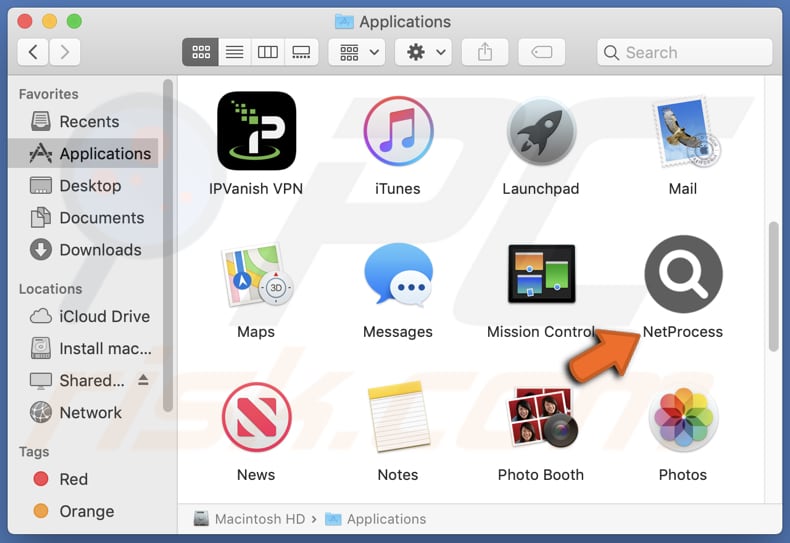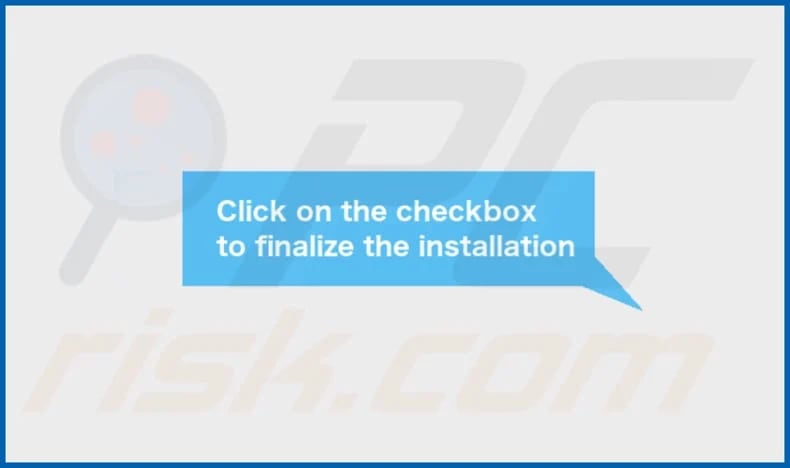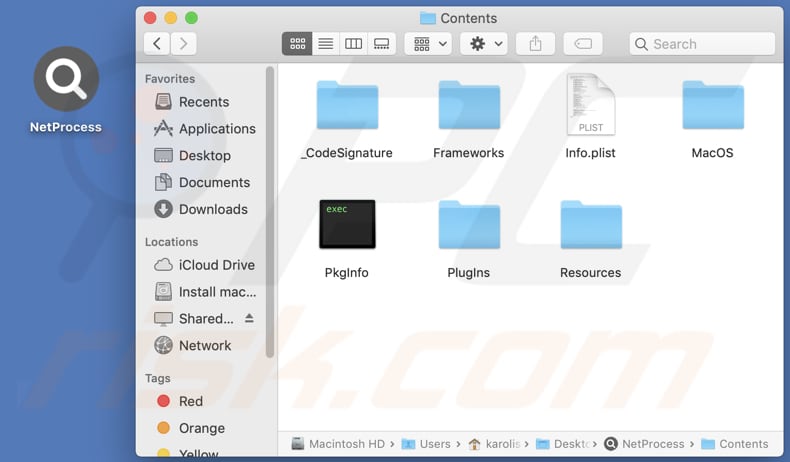Get free scan and check if your device is infected.
Remove it nowTo use full-featured product, you have to purchase a license for Combo Cleaner. Seven days free trial available. Combo Cleaner is owned and operated by RCS LT, the parent company of PCRisk.com.
What kind of application is NetProcess?
During our examination of the NetProcess application, we discovered that it exhibits intrusive advertisements to users, indicating its classification as adware. Adware applications like NetProcess not only display ads but also often collect user data, making them untrustworthy.

NetProcess adware in detail
NetProcess may display various types of ads, including pop-ups, banners, and sponsored links, which can disrupt the browsing experience and lead to unwanted distractions. These ads can redirect users to untrustworthy websites that may promote potentially harmful content, such as fake software downloads, misleading offers, or phishing pages designed to steal personal information.
Also, ads from NetProcess may be designed to run certain scripts to trigger unwanted downloads and installations. Another reason to avoid installing NetProcess is that it may be designed to gather various data, including browsing history, search queries, clicked links, IP addresses, geolocation information, and device identifiers.
Such data can be exploited for targeted advertising or analytics or even shared with third parties for various purposes without the user's knowledge. It is important to know that adware sometimes can access data like credit card details, passwords, financial information, and other sensitive details, which may result in problems like identity theft, monetary loss, and other issues.
Sometimes, adware can function as a browser hijacker by modifying browser settings. This modification may involve changing the default homepage, search engine, and new tab page. Consequently, users may experience frequent redirects to shady websites.
| Name | Ads by NetProcess |
| Threat Type | Adware, Mac malware, Mac virus |
| Detection Names | Avast (MacOS:Adload-AG [Adw]), Combo Cleaner (Gen:Variant.Adware.MAC.AdLoad.13), ESET-NOD32 (A Variant Of OSX/Adware.Synataeb.G), Kaspersky (Not-a-virus:HEUR:AdWare.OSX.Adload.h), Full List (VirusTotal) |
| Additional Information | This application belongs to Adload malware family. |
| Symptoms | Your Mac becomes slower than normal, you see unwanted pop-up ads, you are redirected to dubious websites. |
| Distribution methods | Deceptive pop-up ads, free software installers (bundling), torrent file downloads. |
| Damage | Internet browser tracking (potential privacy issues), display of unwanted ads, redirects to dubious websites, loss of private information. |
| Malware Removal (Windows) |
To eliminate possible malware infections, scan your computer with legitimate antivirus software. Our security researchers recommend using Combo Cleaner. Download Combo CleanerTo use full-featured product, you have to purchase a license for Combo Cleaner. 7 days free trial available. Combo Cleaner is owned and operated by RCS LT, the parent company of PCRisk.com. |
Conclusion
In conclusion, the presence of NetProcess on devices can compromise privacy and security by displaying intrusive ads and potentially collecting sensitive personal information without user consent. It is essential to take proactive measures to remove such adware applications from systems and exercise caution when installing new software to avoid similar risks.
More examples of apps similar to NetProcess are UsualAccess, EngineRotator, and ReviewWebpageClick.
How did NetProcess install on my computer?
Users may unknowingly install adware when they fail to carefully review installation options, such as those labeled "Advanced" or "Custom", during the installation of the desired software. It is common for adware to be bundled with free or questionable software.
Furthermore, adware can be disseminated through deceptive advertisements, pop-ups, or counterfeit download buttons on unreliable pages. Additionally, obtaining files and applications via third-party downloaders, peer-to-peer networks, or similar channels can also lead to the inadvertent installation of adware.
How to avoid installation of unwanted applications?
Be mindful when downloading software, particularly from sources of questionable credibility. Opt for trusted websites or official app stores, which are more likely to provide safe and authentic software. When installing, scrutinize all options to avoid unintentionally installing bundled adware or other undesirable programs.
Furthermore, exercise caution with suspicious ads, pop-ups, or links, especially those offering unrealistic deals or rewards. Stay vigilant on websites with aggressive advertising or dubious content. Regularly updating operating systems and software and employing reputable antivirus or anti-malware tools is also recommended.
If your computer is already infected with NetProcess, we recommend running a scan with Combo Cleaner Antivirus for Windows to automatically eliminate this adware.
A message that appears after the installation of NetProcess:

The installation folder of NetProcess:

Instant automatic malware removal:
Manual threat removal might be a lengthy and complicated process that requires advanced IT skills. Combo Cleaner is a professional automatic malware removal tool that is recommended to get rid of malware. Download it by clicking the button below:
DOWNLOAD Combo CleanerBy downloading any software listed on this website you agree to our Privacy Policy and Terms of Use. To use full-featured product, you have to purchase a license for Combo Cleaner. 7 days free trial available. Combo Cleaner is owned and operated by RCS LT, the parent company of PCRisk.com.
Quick menu:
- What is NetProcess?
- STEP 1. Remove NetProcess related files and folders from OSX.
- STEP 2. Remove NetProcess ads from Safari.
- STEP 3. Remove NetProcess adware from Google Chrome.
- STEP 4. Remove NetProcess ads from Mozilla Firefox.
Video showing how to remove NetProcess adware using Combo Cleaner:
NetProcess adware removal:
Remove NetProcess-related potentially unwanted applications from your "Applications" folder:

Click the Finder icon. In the Finder window, select "Applications". In the applications folder, look for "MPlayerX", "NicePlayer", or other suspicious applications and drag them to the Trash. After removing the potentially unwanted application(s) that cause online ads, scan your Mac for any remaining unwanted components.
DOWNLOAD remover for malware infections
Combo Cleaner checks if your computer is infected with malware. To use full-featured product, you have to purchase a license for Combo Cleaner. 7 days free trial available. Combo Cleaner is owned and operated by RCS LT, the parent company of PCRisk.com.
Remove adware-related files and folders

Click the Finder icon, from the menu bar. Choose Go, and click Go to Folder...
 Check for adware generated files in the /Library/LaunchAgents/ folder:
Check for adware generated files in the /Library/LaunchAgents/ folder:

In the Go to Folder... bar, type: /Library/LaunchAgents/

In the "LaunchAgents" folder, look for any recently-added suspicious files and move them to the Trash. Examples of files generated by adware - "installmac.AppRemoval.plist", "myppes.download.plist", "mykotlerino.ltvbit.plist", "kuklorest.update.plist", etc. Adware commonly installs several files with the exact same string.
 Check for adware generated files in the ~/Library/Application Support/ folder:
Check for adware generated files in the ~/Library/Application Support/ folder:

In the Go to Folder... bar, type: ~/Library/Application Support/

In the "Application Support" folder, look for any recently-added suspicious folders. For example, "MplayerX" or "NicePlayer", and move these folders to the Trash.
 Check for adware generated files in the ~/Library/LaunchAgents/ folder:
Check for adware generated files in the ~/Library/LaunchAgents/ folder:

In the Go to Folder... bar, type: ~/Library/LaunchAgents/

In the "LaunchAgents" folder, look for any recently-added suspicious files and move them to the Trash. Examples of files generated by adware - "installmac.AppRemoval.plist", "myppes.download.plist", "mykotlerino.ltvbit.plist", "kuklorest.update.plist", etc. Adware commonly installs several files with the exact same string.
 Check for adware generated files in the /Library/LaunchDaemons/ folder:
Check for adware generated files in the /Library/LaunchDaemons/ folder:

In the "Go to Folder..." bar, type: /Library/LaunchDaemons/

In the "LaunchDaemons" folder, look for recently-added suspicious files. For example "com.aoudad.net-preferences.plist", "com.myppes.net-preferences.plist", "com.kuklorest.net-preferences.plist", "com.avickUpd.plist", etc., and move them to the Trash.
 Scan your Mac with Combo Cleaner:
Scan your Mac with Combo Cleaner:
If you have followed all the steps correctly, your Mac should be clean of infections. To ensure your system is not infected, run a scan with Combo Cleaner Antivirus. Download it HERE. After downloading the file, double click combocleaner.dmg installer. In the opened window, drag and drop the Combo Cleaner icon on top of the Applications icon. Now open your launchpad and click on the Combo Cleaner icon. Wait until Combo Cleaner updates its virus definition database and click the "Start Combo Scan" button.

Combo Cleaner will scan your Mac for malware infections. If the antivirus scan displays "no threats found" - this means that you can continue with the removal guide; otherwise, it's recommended to remove any found infections before continuing.

After removing files and folders generated by the adware, continue to remove rogue extensions from your Internet browsers.
Remove malicious extensions from Internet browsers
 Remove malicious Safari extensions:
Remove malicious Safari extensions:

Open the Safari browser, from the menu bar, select "Safari" and click "Preferences...".

In the preferences window, select "Extensions" and look for any recently-installed suspicious extensions. When located, click the "Uninstall" button next to it/them. Note that you can safely uninstall all extensions from your Safari browser - none are crucial for regular browser operation.
- If you continue to have problems with browser redirects and unwanted advertisements - Reset Safari.
 Remove malicious extensions from Google Chrome:
Remove malicious extensions from Google Chrome:

Click the Chrome menu icon ![]() (at the top right corner of Google Chrome), select "More Tools" and click "Extensions". Locate all recently-installed suspicious extensions, select these entries and click "Remove".
(at the top right corner of Google Chrome), select "More Tools" and click "Extensions". Locate all recently-installed suspicious extensions, select these entries and click "Remove".

- If you continue to have problems with browser redirects and unwanted advertisements - Reset Google Chrome.
 Remove malicious extensions from Mozilla Firefox:
Remove malicious extensions from Mozilla Firefox:

Click the Firefox menu ![]() (at the top right corner of the main window) and select "Add-ons and themes". Click "Extensions", in the opened window locate all recently-installed suspicious extensions, click on the three dots and then click "Remove".
(at the top right corner of the main window) and select "Add-ons and themes". Click "Extensions", in the opened window locate all recently-installed suspicious extensions, click on the three dots and then click "Remove".

- If you continue to have problems with browser redirects and unwanted advertisements - Reset Mozilla Firefox.
Frequently Asked Questions (FAQ)
What harm can adware cause?
Adware can lead to a range of issues for users. It often inundates them with intrusive advertisements, slowing their browsing experience and disrupting workflow. Additionally, adware may compromise privacy by collecting user data without consent, potentially leading to identity theft or other forms of cyber exploitation.
What does adware do?
Adware is a type of software designed to flood users with unwanted advertisements. Additionally, adware may collect user data and redirect users to potentially harmful websites through browser hijacking.
How do adware developers generate revenue?
Usually, they get paid by advertisers to display ads to users through their adware programs. This could include pay-per-click (PPC) ads, pay-per-impression (PPI) ads, or affiliate marketing programs where they earn commissions for driving traffic or sales to specific products or websites.
Will Combo Cleaner remove NetProcess adware?
It is important to bear in mind that manual removal might not always be effective, as remnants of files could still lurk within the system. Combo Cleaner is equipped to scan your computer thoroughly and remove any installed adware-type applications.
Share:

Tomas Meskauskas
Expert security researcher, professional malware analyst
I am passionate about computer security and technology. I have an experience of over 10 years working in various companies related to computer technical issue solving and Internet security. I have been working as an author and editor for pcrisk.com since 2010. Follow me on Twitter and LinkedIn to stay informed about the latest online security threats.
PCrisk security portal is brought by a company RCS LT.
Joined forces of security researchers help educate computer users about the latest online security threats. More information about the company RCS LT.
Our malware removal guides are free. However, if you want to support us you can send us a donation.
DonatePCrisk security portal is brought by a company RCS LT.
Joined forces of security researchers help educate computer users about the latest online security threats. More information about the company RCS LT.
Our malware removal guides are free. However, if you want to support us you can send us a donation.
Donate
▼ Show Discussion